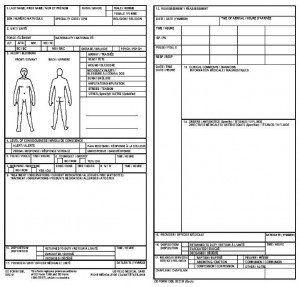Continue to monitor the casualty as you continue your evaluation and treatment.
If the casualty is able, he may drink water. Do not give any thing by mouth to a patient who is nauseous, vomiting, or has an altered mental status.
a. Monitor Vital Signs.
Continue to take the casualty’s vital signs every 5 minutes until they return to normal; then take his vital signs every 15 minutes. Check the casualty’s capillary refill by pressing on his nails and observing the return of color to the nail beds.
b. Monitor Level of Consciousness.
Check the casualty’s level of consciousness every 5 to 15 minutes as you monitor his vital signs.
c. Monitor IV Flow Rate.
If the casualty’s blood pressure stabilizes with the return of peripheral pulses, discontinue the IV and monitor the patient.
d. Record Treatment.
Initiate a U.S. Field Medical Card on the casualty. Record treatment procedures and vital signs on the card.

e. Apply Pneumatic Counterpressure Device (PCPD), If Applicable.
If the casualty is not responding to treatment for shock, medical anti-shock trousers (MAST) are available, and their use is appropriate (paragraph 7-5), apply them using the procedures given in paragraphs 7-6 through 7-8. Medical anti-shock trousers are usually found in a battalion aid station or other medical treatment facility.
NOTE: There is more than one type of MAST device. The MAST devices are also called military anti-shock trousers.
